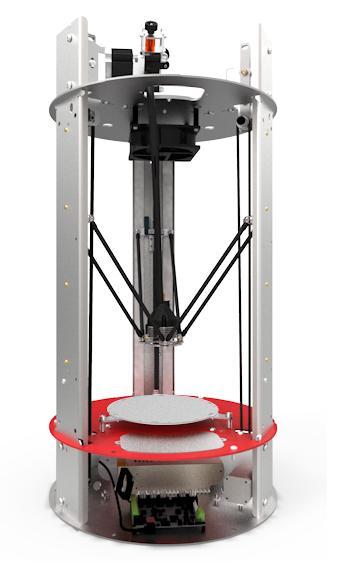 When it comes to desktop FFF/FDM 3D printers, we are limited to two different types of technology. There are the more traditional and conventional Cartesian style printers which utilize a box shaped gantry where the hot end is moved on the X/Y/Z axes using common gantry techniques. Then there are the less popular, but no less effective delta robot style 3D printers which utilize delta robotics tp attach the 3D printer hot end to three separate arms which also are capable of precisely moving the print head in all three dimensions (X,Y,Z). When it comes to choosing the 3D printer that is right for you, it’s really all about preference. Delta machines are typically able to provide more print area per printer size, but also are limited more in the X and Y directions.
When it comes to desktop FFF/FDM 3D printers, we are limited to two different types of technology. There are the more traditional and conventional Cartesian style printers which utilize a box shaped gantry where the hot end is moved on the X/Y/Z axes using common gantry techniques. Then there are the less popular, but no less effective delta robot style 3D printers which utilize delta robotics tp attach the 3D printer hot end to three separate arms which also are capable of precisely moving the print head in all three dimensions (X,Y,Z). When it comes to choosing the 3D printer that is right for you, it’s really all about preference. Delta machines are typically able to provide more print area per printer size, but also are limited more in the X and Y directions.
For one company, run by Myriam & Philippe Boichut, they’ve been building and selling delta style 3D printers for quite some time. This week, however, they released their latest version of their rather popular SpiderBot 3D printer.
SpiderBot v2.1, which comes in three different forms — the Standard Kit (starting at 1140,00 €) , Pro Kit and Custom version — has officially been unveiled and made available for purchase this week, with a mere lead time of just 3-5 days.
For those unfamiliar with SpiderBot, their printer features a “tilting dual head” extruder which allows for the printing of more complex parts. It also includes some other high end features such as linear guides, magnetic ball ends, stainless steel rails, a full metal chassis, an enclosure, and the special TSS (Three Sphere) System, which is explained as follows:
“The extrusion head is supported by a single plate with only 3 spheres and the Rod-End magnets. The TSS is a combination of magnets with spherical bearing surfaces at every end of the 6 carbon tubes connected to three spheres on the support plate that holds the extrusion head. The support plate has only three spheres so that each sphere is always perfectly positioned by two arms. Through this support by only 3 points, it is always perfectly parallel to the heated bed. Due to the magnetic connection that can be broken by applying the right amount of force, maintenance on the print head is easily done.”
On this latest version 2.1 of the SpiderBot, the company has worked very hard to improve the print quality of this TSS system by improving the ventilation and air flow within the printers’ enclosures. Using simulations that they compiled, they were able to study the airflow that took place within the SpiderBot, and used this information in order to build a system that can use the hot air within the printer’s enclosure to keep the printed part warm enough to prevent warping or shrinkage, but at the same avoid hot spots within the enclosure and the print bed.
The printer’s main fan has been inclined, which creates two separate air flow streams (seen in red in the photos below) rather than just one. Surrounding the print bed, SpiderBot has installed special conical air deflectors (seen in orange in the photos below) which take what would have previously been “lost hot air” and redirect it onto the object which is in the process of being printed.
This allows parts to receive approximately three time the hot air than on other similar 3D printers, thus preventing warping on ABS printed plastic parts. This is really a revolutionary system for delta style 3D printers, one which should really enhance the print quality of printed objects, specifically objects printed in ABS.
What do you think about these new redesigns seen in the SpiderBot v2.1? Will this really enhance the quality of prints? Discuss in the SpiderBot 2.1 forum thread on 3DPB.com.
Subscribe to Our Email Newsletter
Stay up-to-date on all the latest news from the 3D printing industry and receive information and offers from third party vendors.
You May Also Like
3D Printing Financials: Steakholder Foods Balances Losses and 3D Printed Tech Advances in 2023
A pioneer in the field of 3D printed meat and fish, Steakholder Foods (Nasdaq: STKH) disclosed its 2023 financial results, a year highlighted by technological progress but overshadowed by financial...
3D Printing Financials: Protolabs’ Q1 3D Printing Revenue is Flat, Company Advances in Technology Push
Protolabs (NYSE: PRLB) has kicked off 2024 with a mild boost in revenue, revealing how the Minnesota-based company manages to adapt and thrive even in uncertain market conditions. While the...
Supply Chain Management and the Role of 3D Printing Digital Inventories
As the additive manufacturing (AM) industry grows beyond its humble roots as a rapid prototyping technology, it has been adopted by some of the world’s leading companies to produce not...
3D Printing Financials: Materialise’s Profitability Amid Revenue Dip in Q1 2024
Materialise (Nasdaq: MTLS) has released its first-quarter earnings for 2024, highlighting a challenging quarter with some key advances despite a dip in revenue. While navigating a mixed performance across its...

































